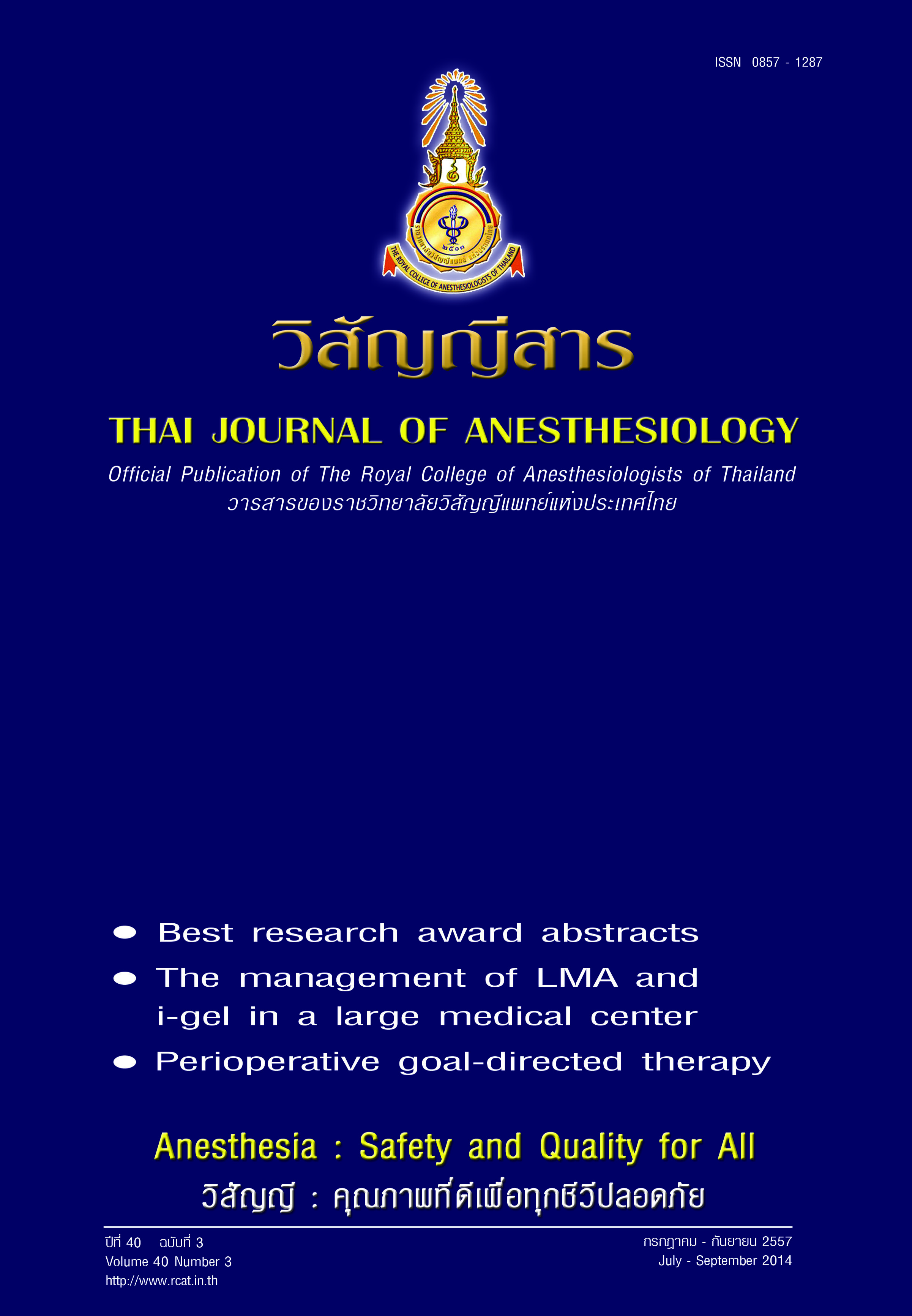Continuous femoral nerve block decreased postoperative analgesia and side effect of morphine in patient who received total knee replacement in Bhumibol Adulyadej Hospital : A
Main Article Content
Abstract
Background: To evaluate the new technique in patients who received continuous femoral nerve block (CFNB) with local anesthetics through a catheter for total knee replacement (TKR)
Methods: Retrospective Review: one year retrospective study of 99 women and 13 men aged 50 to 84 years with matched characteristics underwent TKR and received either continuous FNB with local anesthetics through a catheter (CFNB group) (n = 66) or non - femoral nerve block (NCFNB group) (n = 46). All operations were performed according to the standard protocol. NRS (numeric rating score) scale and morphine consumption at 12 hour after surger. Surgery side effect of morphine (nausea, vomiting, pruritus and hypotension) in both groups were compared.
Results: The continuous femoral nerve block groups have significantly lower NRS scale and lower received morphine than non - femoral nerve block groups (p < 0.05). Side effect of morphine, both nausea and vomiting, pruritus, hypotension continuous femoral nerve block groups have lower than did not receive continuous femoral nerve block groups
Conclusion: The study shows reduction of NRS scale, morphine consumption and decrease side effect of morphine such as nausea and vomiting, pruritus, hypotension, in patients who receive continuous femoral nerve block versus those who non - femoral nerve block
การใส่สายระงับเส้นประสาท Femoral สามารถลดความปวดหลังการผ่าตัดและผลข้างเคียงของยาระงับปวดในผู้ป่วยเปลี่ยนข้อเข่าในโรงพยาบาลภูมิพลอดุลยเดช: การศึกษาย้อนหลัง
บทนำ: เพื่อประเมินวิธีการระงับปวดหลังผ่าตัดวิธีใหม่โดยการใส่สายการระงับเส้นประสาท femoral ในผู้ป่วยที่ทำการผ่าตัดเปลี่ยนข้อเข่าและศึกษาผลข้างเคียงของยาระงับปวดที่ได้หลังการผ่าตัดเปลี่ยนข้อเข่า
วิธีการศึกษา: ศึกษาเวชระเบียนผู้ป่วยที่มารับการผ่าตัดเปลี่ยนข้อเข่า ในช่วง 1 ม.ค. ถึง 31 ธ.ค. พ.ศ. 2556 เป็น เพศหญิง 99 ราย เพศชาย 13 ราย อายุระหว่าง 50 – 84 ปี โดยแบ่งเป็นกลุ่ม ใส่สายระงับเส้นประสาท femoral จำนวน 66 ราย กลุ่มไม่ใส่สายระงับเส้นประสาท femoral 46 ราย ทั้ง 2 กลุ่มได้รับยาระงับปวดอื่นเหมือนกันโดยจะมีการวัดคะแนนความปวดเป็นค่าตัวเลข (numeric rating score) และปริมาณการใช้มอร์ฟีนที่ 12 ชั่วโมงหลังการผ่าตัด ผลข้างเคียงของยามอร์ฟีน เช่น คลื่นไส้อาเจียน อาการคัน ความดันโลหิตต่ำ ซึ่งจะนำค่าทั้ง 2 กลุ่มมาทำการเปรียบเทียบ ผลการศึกษา: กลุ่มใส่สายระงับเส้นประสาท femoral มีคะแนนความปวดที่ 12 ชั่วโมงหลังการผ่าตัดต่ำกว่ากลุ่มไม่ใส่สายระงับเส้นประสาท femoral อย่างมีนัยสำคัญทางสถิติ และ กลุ่มใส่สายระงับเส้นประสาท femoral มี ปริมาณการใช้มอร์ฟีนที่ 12 ชั่วโมง ต่ำกว่า กลุ่มไม่ใส่สายระงับเส้นประสาท femoral นอกจากนั้นกลุ่มใส่สายระงับเส้นประสาท femoral มีอุบัติการณ์ของผลข้างเคียงของยามอร์ฟีน เช่น คลื่นไส้อาเจียน อาการคัน ความดันโลหิตต่ำ ต่ำกว่า กลุ่มไม่ใส่สายระงับเส้นประสาท femoral สรุป
ผลการศึกษา: การศึกษานี้พบการลดลงของคะแนนความปวด ปริมาณการใช้มอร์ฟีน และ ผลข้างเคียงของยามอร์ฟีน เช่น คลื่นไส้อาเจียน อาการคัน ความดันโลหิตต่ำในกลุ่มใส่สายระงับเส้นประสาท femoral เปรียบเทียบกับกลุ่มไม่ใส่สายระงับเส้นประสาท femoral


